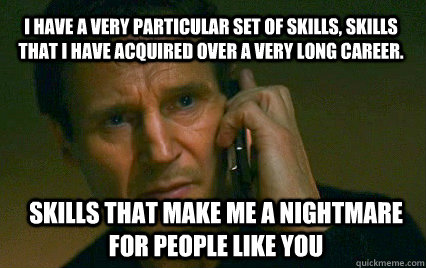Knowledge is power. Knowing how to reach our audiences and understanding their similarities and contrasts can make the difference between success and failure.
Here we explore one audience group in particular – sharing some advice and guidance on how to communicate effectively with highly skilled, elite individuals and teams.
Understanding our audiences
A deep understanding of our audiences helps us to know which messages will work best, how to deliver them, how people will react and what will or won’t be accepted. It helps us to advise others and sets communicators apart as a credible, knowledgeable and valuable asset. With the latest research from VMA Group’s Inside Insight 2016 citing ‘maintaining a seat at the table’ and ‘being recognised as a strategic asset’ as two of the single biggest challenges facing IC pros over the next five years, demonstrating our expertise and influence in this area is a must.
In our work supporting organisations with their comms activities, one thing we can always guarantee is that one size never fits all.
We all have our preferences and consume information differently. Which is why audience segmentation, recognising sub-groups and understanding their needs is vital. And in our experience, some groups present more complex challenges than others.
ENGAGING ELITE COMMUNITIES
 One such group that we work with is what we have called the ‘elite’. These communities tend to work within highly skilled, technical based sectors in roles such as professors, scientists and engineers. They pose very specific challenges when it comes to communication.
One such group that we work with is what we have called the ‘elite’. These communities tend to work within highly skilled, technical based sectors in roles such as professors, scientists and engineers. They pose very specific challenges when it comes to communication.
Using a broad brush to describe the most challenging of their character traits, they can be ego-driven and may believe themselves to be superior, ‘above the law’ and beyond general levels of communication. They could be classified as ‘refuseniks’ (well informed but disinterested), a term used by Bill Quirke to describe the general attitude trait of a particular audience.
They’re held in high esteem and often have an essential presence within their chosen industry that supports the organisation.
It’s these peoples’ vast experience, passion for their work and unquestionable value to the business that seems to distance them and makes them hard to reach.
ADVICE FROM OUR NETWORK
In order to find out how others communicate with such individuals, we put the question to our network:
How do you engage with ‘the elite’?
As ever, we had a strong response and some excellent advice was shared. We’ve drawn out ten of the principal points raised:
1. Creatively connect them with business objectives
“Engage their intellect,” says Jamie Tott, Innovation, Change and Communication Expert. “Facilitate creative and critical problem solving groups to connect the ‘elite’ with business imperatives. Encourage them to frame & reframe problems you’re trying to solve, to generate ideas and develop technical solutions to answer them. I’ve spent years in the company of uber-educated people with brains like small planets. My experience generally speaking is, as people become more educated, the more that education inhibits openness to new ideas and ways of working. It’s a neurological certainty that studying patterns of theory from a single field, or handful of fields, forms ever-deeper rivulets of associative memory based on what we’ve learned. We become defined by it and it colours our thinking.”
2. Give them the time and space to stretch their own thinking
“Allow them to exercise their intellectual curiosity to stretch their own thinking,” adds Jamie. “Not doing so is like breeding a racehorse, putting it to pasture, then still expecting it to win a race.”
3. Tell people what they need to know, not everything we have to tell
“Highly skilled people are really passionate about their work and its potential and they get frustrated by other’s lack of understanding,” says Priya Bates, Senior Communication Executive and President of Inner Strength Communication Inc. “I’ve worked for years with IT professionals. With the techies who understood the complex information, we used ‘Speeds and Feeds’ to deliver the ‘need to know’ news. For the rest, we had to ask a lot of questions to find out what really mattered to them.”
4. Use your ignorance to your advantage
“I found that if I didn’t understand what they were talking about, no one else would either and that would help us meet our goals or accomplish our purpose. Identifying goals together is key,” adds Priya.
5. Run problem solving workshops
“I’ve been running a program with just such elite communities globally for the past year, using an approach called The Dialogue Box, a practical tool exploring five zones – intelligence, emotion, interpretation, narrative and dialogue. It’s been incredibly successful,” says David Cowan, author of Strategic Internal Communication: How to Build Employee Engagement and Performance. “We run workshops in groups of 10-15 where they problem-solve issues relating to their own business. I conclude from this: use a problem-solving approach in workshops, keep groups small and highly participative, give them a solution to take away with them. Then they’ll appreciate it.”
6. Allow people to come to their own conclusions
“Speaking from experience, I’ve found engineers are most satisfied when given the facts so they can ‘join the dots’ and come to their own conclusions,” says Matthew Hall, Senior Communications Professional and Principal Consultant at Mobius Communications.
7. Provide strong leadership
Matthew adds, “That said, a trusted and respected leader who can offer a strong narrative and view of the future is also very much appreciated.”
8. Listen and dig deep up front
“We work with specific communities within large organisations and do a lot of listening and talking up front to dig deeper into what the audience wants to know – and why,” says Suzanne Peck, Communications Strategist and Managing Director of Sequel Group. “For most, they start with the shiny tech but then it becomes more about what’s right for the audience regarding tone, style, design and the right media to reach them. I’ve also found that little and often works well.”
9. Establish goals and a clear WIIFM
In 2015 an entry from Russia called Comlab won an IABC Gold Quill award of Excellence. There was a huge communication gap between science professors and their research and scientific journalist who covered the research in media. What they knew was that scientists wanted media and journalists wanted to be able to cover local science, but the two simply couldn’t understand each other. They brought together communication professionals, journalists and the PhDs to set goals and problem solve. What they established was a clear WIIFM (what’s in it for me), and business goals on both sides. They used collaboration and communication to help connect these communities. They also created operational solutions that would be easy for both groups to work with. They really showed what was possible when strategic communication professionals got involved.
10. Help the elite communicate out
Communication is a two-way street. These individuals and teams are technically brilliant but can lack the skills required to translate their expertise and value in a way that others will understand. Help them to share what they do in engaging and coherent terms and offer practical support so they can build trust in comms through experiencing it first-hand.
IN SUMMARY
Just like any other audience group, these individuals will have their own attitudes and opinions towards the business, channel preferences and key interests and will need to be communicated with in a way that addresses these factors.
Several key themes emerged – engage in a two way conversation, listen to what people want, establish goals, provide a strong strategic narrative, be mindful of what content and information is shared and consider how frequently it’s communicated.
This may sound comparable with other challenges and audiences – there are many similarities, but with these communities it’s a case of being even more aware of how we approach them – understanding how they like to absorb information is crucial. Establishing exactly what they need to know rather than what we perceive they should be told is also vital. Creating an environment where they can explore new ideas and different ways of working to bring them closer to the business will help to reduce the distance and bridge the comms gaps. Connect them directly with business challenges, give them problems to solve and bring out their critical thinking side.
We’re very grateful to all those who took the time to share such excellent resources, insights and experiences. Thank your for all your contributions.
Do you work with similar audiences? What are your biggest communication challenges and how do you overcome them? Have you found effective methods to engage the elite? We’d love to hear your experiences.
















